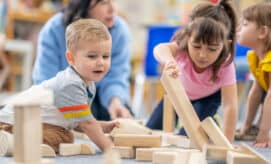The toddler years are full of growth, curiosity, and exploration! Educators who care for little ones at this age have a unique opportunity to provide support that nurtures a child’s foundation for ongoing development and learning. In this article, we explore approaches to toddler care & education that incorporate thoughtful interactions and engaging learning experiences to support healthy development during these important early years.
1. Create Opportunities for Sensory Exploration
Many toddlers enjoy opportunities for sensory learning through tactile exploration. Using their fingers and hands to squish a ball of playdough or draw shapes in the sand helps children develop muscles and motor skills that they will later use to hold pencils for writing. When we talk with little ones as they engage in sensory play, they get to hear and use new words to describe what they are doing (pulling, digging) and what they are experiencing (cool, smooth, rough).
We can encourage sensory exploration in a variety of ways – such as inviting children to help prepare a recipe, setting up a sensory bin in the classroom, or engaging children in art projects that incorporate a variety of textures. If you’re looking for more sensory activity inspiration, you might enjoy this G2K article from the archives, Sensory Activities for Young Children, which shares a variety of DIY sensory experiences.
2. Encourage Creativity through Open-ended Play
Open-ended play is a type of unstructured play in which children are offered materials to use in any way they choose. There is no pre-determined outcome in open-ended play activities, so children are free to follow their imagination as they create and explore.
Playing and building with blocks, Legos, or Magnatiles is an open-ended activity that is fun for toddlers while being rich in learning opportunities. You might set out more than one type of item, like blocks and small plastic animals, or offer children a variety of loose parts that they can utilize in new and interesting ways! This type of unstructured play invites children to get creative, utilize problem-solving skills, and express themselves.
3. Incorporate Physical Movement
During toddlerhood, little ones are on the move! Tapping into this natural energy and desire for physical movement is a great way to support toddler development in early care & learning programs. An article from ZERO TO THREE explains, “movement is not just important for helping children grow physically strong and healthy. It is also a key factor in their overall development. Through movement, children develop good thinking and communication skills as they explore and interact with their world. Movement also builds self-confidence. Children feel competent, physically and emotionally, when they use their bodies to communicate and solve problems.”
We can encourage movement in early learning classrooms by turning on music and having a dance party, going for a walk outside, or setting up a simple obstacle course in your yard or classroom. If you’re looking for more ways to incorporate movement into your classroom activities, you might enjoy these G2K articles from the archives:
4. Promote Independence
As children enter their toddler years, they begin to develop a sense of self, along with their own opinions and ideas. This important time in a child’s cognitive and social-emotional development can be nurtured by encouraging toddler independence.
In early learning environments, we can encourage children to feel independent by inviting them to help with tasks around the classroom, such as cleaning up after themselves, putting on their own shoes or jackets to go outside, and making their beds for naptime. Little ones love finding ways to help, and encouraging them to demonstrate their ability to be helpers builds their self-confidence!
5. Talk about Feelings
As early care & learning providers know, toddlerhood is a time of big feelings. At this age, children’s brains are still developing the emotional skills that are necessary to regulate emotions. When toddlers experience big feelings, we can talk with them about their emotions so they can learn techniques for managing them. You might say something like, “I can see that you’re feeling really angry right now! Let’s take a break for a few minutes and come back when you’re feeling more calm.” This interaction labels the child’s feelings, which helps them to develop their emotional vocabulary, while also helping them to learn the importance of taking a break to regulate themselves.
Additional tools for helping toddlers calm themselves down so they can manage their feelings include: taking deep breaths, hugging stuffed animals, or going outside for a moment.





